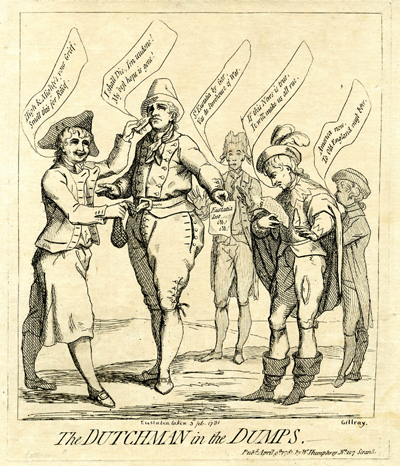Dutchman in the Dumps
Like other early prints by Gillray, Dutchman in the Dumps has a lot more in common with static emblematic satires of the 1740's than with his later and espressive caricatures. In the first place, it shows five figures unrealistically situated in the same unspecified visual space with only a symbolic rationale for the combination. Second, none of the figures is a caricature of a specific individual. Each one is instead a symbolic representation of a country: England, Holland, France, Spain, and America. But unlike the more traditional emblems of truth or justice, which had a long visual tradition or were specifically identified with an accompanying "key," the countries here are identified by certain popular national stereotypes—the British tar, the fat and burgerlich Dutchman, the foppish Frenchman, and so on. A hint of things to come, especially in comic caricature.

©Trustees of the British Museum
The print was prompted by the seizure of the Dutch island of St. Eustacius by the British navy under Admiral George Rodney in February of 1781. (Hence the British seaman lifting the Dutchman's purse, and the note, saying "Eustatia's lost. Oh! Oh!") The text bubbles express (in formalistic rhyming couplets) the mocking triumph of the British tar, and the unhappy reactions of the other countries affected by the event.
ENGLAND:
High & Mighty's Your Grief.
Smell this for Relief.
HOLLAND:
I shall Die, I'm undone!
My best hope is now gone!
FRANCE:
St Eustatia by Gar,
Vas de Storehouse of War.
SPAIN:
If this News is true,
It will make us all rue.
AMERICA:
America now,
To Old England must bow.
St. Eustacius was strategically positioned in the midst of Caribbean islands controlled by other countries, including England, France, Spain, and Denmark. Since 1756 it had made a fortune for the Dutch by remaining purposely neutral amid the restrictive trade laws of the other islands, buying and selling goods from and to anyone irrespective of his country of origin. All the countries gained from this free trade, but perhaps the principal beneficiaries of the arrangement were America which at this time (1781) used the island as a perfect pass through for communications abroad, and France which, along with America, found it a critical source of guns and ammunition.
The British were naturally unhappy with what they saw as Dutch support for American independence and, in December of 1780, declared war against the Dutch, sending Rodney to take the island. As the print suggests, the seizure of St Eustacius was devastating for the Dutch economy.
Sources and Reading
- Commentary from the British Museum on Dutchman in the Dumps
- Sint Eustatius, Wikipedia
Comments & Corrections
NOTE: Comments and/or corrections are always appreciated. To make that easier, I have included a form below that you can use. I promise never to share any of the info provided without your express permission.